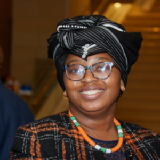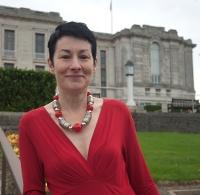Blog
Unless otherwise stated, content is shared under CC-BY-NC Licence
Tackling the digital preservation challenge at the University of Glasgow
Clare Paterson is Senior Archivist (Business & Digital) at the University of Glasgow.
The digital preservation challenges we face at Glasgow will be familiar across the DPC community: increasing volumes of digital data which do not fit the well-honed record-keeping procedures of our long-familiar paper-based systems; expectations of quick, if not immediate, availability of digital information to support our work, research, and learning; and the ever-shifting landscape of technology to name just a few.
Since 2015, teams across the University have been collaborating through our Digital Preservation Working Group (DPWG) and building the case for capacity, resource, and expertise. This collaborative approach benefits us greatly. Through our DPWG we bring together colleagues from the Digital Library Team, IT Services, Research Information Management (RIM), Data Protection and Freedom of Information Office (DP&FoI), Archives & Special Collections (ASC) and the Digital Curation Centre to share expertise, discuss challenges, and work together on our shared priorities. Beyond the University, we are always eager to engage with the digital preservation, archival, and open research communities to learn from others experiences and expertise.
Whilst aware of the scale of the digital preservation challenges we face; we are making progress, both as a working group and as individual teams working in our own areas. These are some of our highlights:
Digital Preservation Futures: Your questions answered
Following on from our excellent Digital Preservation Futures Webinar Series with DPC Supporters Arkivum, Artefactual, AVP, LIBNOVA and Preservica… there were some questions we just didn’t have time to ask! In this blog post, our Supporters provide answers to those questions:
IDCC21/RDAVP17: An out of this world data curation and digital preservation experience
Thandokazi Maceba is the Data Curator at Digital Library Services, University of Cape Town. She attended IDCC 2021 and the RDA 17th Virtual Plenary with support from the DPC’s Career Development Fund, which is funded by DPC Supporters.
In August 2020 I joined the University of Cape Town (UCT) as a Data Curator at the Digital Library Services department in the Libraries. In this role, my responsibilities center around supporting and enhancing digital scholarship and digital preservation activities at UCT. I collaborate across departments in the Libraries, and with the eResearch Centre to develop and maintain workflows and tools that facilitate faculty and staff use of various digital data publishing and preservation platforms.
UCT Libraries joined the DPC in October 2020, and our affiliation has already afforded me the opportunity to participate in a number of online courses and events, including the IDCC 21, RDA VP17 and the IDCC/RDA Unconference (19-22 April 2021), enabled through the DPC Career Development Fund. Without this Fund, I would not have been able to attend these conference proceedings and I would like to express my gratitude to the DPC for providing me with this valuable learning opportunity. In this blog, I will share some of the things I have learned from the conferences.
The theme for IDCC21 was: ‘Data quality and data limitations: working towards equality through data curation.’ The theme for the RDA VP17 was ‘Opening Data for Global Changes.’ Attending these conferences was of paramount importance for me, as I have not yet had many opportunities for skills development in the data curation and digital preservation field. I wanted to develop my knowledge about data curation, open science and digital preservation.
Teaming up to save the bits: digital sustainability in Wales
Sally McInnes is Chair of the ARCW Digital Preservation Group and Head of Unique Collections and Collections Care at the National Library of Wales.
The ability to remotely connect and network with colleagues has been one of the positives that have arisen from these challenging times. From my home in Aberystwyth, which is not always the most accessible of places by non-digital highways, I am able to engage with experts, learn from their experiences and contribute to discussions on a global basis. Although we have been building digital preservation capacity in Wales for many years, these encounters have inspired us to extend the reach of the work being undertaken to promote digital sustainability. Working with the sector, developing the use of digital technologies and sharing skills are key elements of the National Library of Wales’s (NLW) new strategic plan ‘A Library for Wales and the World, 2021-26’, which will be launched shortly.
IDCC21 Keynote: Indigenous Sovereignty of Language Data – The Mãori Example
Iram Safdar is the Digital Archivist at Historic Environment Scotland. She attended IDCC 2021 and the RDA 17th Virtual Plenary with support from the DPC’s Career Development Fund, which is funded by DPC Supporters
Thank you to the Digital Preservation Coalition Career Development Fund, without which I would not have been able to attend the International Digital Curation Conference (IDCC21). This year, the IDCC took place virtually, over one day and was a co-located event with the RDA 17th Virtual Plenary, as part of an Edinburgh week of data management. This is the first time I have been able to attend the IDCC, and coming from a background in the archives profession, specialising in digital archives, I was looking forward to learning more about the ways we can manage and curate our digital data, and make it accessible.
The opening keynote, titled ‘Indigenous Sovereignty of Language Data – the Māori example’, was delivered by Te Taka Keegan, Associate Professor in Computing, and Associate Dean Mãori for the Division of Health, Engineering, Computing & Science at the University of Waikato. A Māori language activist, Te Taka started the keynote with a greeting in his language, roughly translating to ‘Honor and glory above, peace on Earth, goodwill to everyone’.
Te Taka noted that there is a significant community undertaking research based on open data and utilising big data to generate resources and initiatives, however, Te Taka identified a few issues with this in terms of Indigenous data. Te Taka observed the increase in collections using Indigenous data, that Indigenous communities themselves are not aware of. Furthermore, collections are generally not own by Indigenous Peoples, and they don’t have a say on how they are run, what information is stored – the crux of the issue being, Indigenous information is being made available that Indigenous Peoples have no control over.
Archives in the UK/Republic of Ireland & AI (AURA): Some Findings for the Future of Archives and AI
Natasha Kitcher, Doctoral Researcher in the School of Social Sciences and Humanities at Loughborough University. She is Research Assistant for the AURA Project, working with Dr Lise Jaillant at Loughborough.
Last September, Dr Annalina Caputo, Assistant Professor in the School of Computing at Dublin City University, shared with the DPC community news of the AURA Network (https://www.dpconline.org/blog/aura-unlocking-cultural-assets). This AHRC-IRC research networking project brings together an interdisciplinary group of stakeholders from Digital Humanists to Computer Scientists to consider the past, present, and future of born-digital archives.
Now, almost eight months later, we are able to share some of the findings of the network with you.
Much like the born-digital archives it considers, this network was born-digitally thanks to coronavirus, which has facilitated discussions between a far-flung group of researchers and professionals in Libraries, Archives and Museums. While the group formed to consider access and usability of born-digital archives, the virtual nature of workshop attendance over the last few months has enabled scholars, archivists, librarians and other stakeholders from across the globe and at varying stages of their careers to engage in AURA’s debates.
Negotiating a deal - the groundwork
Carlo Iacono is Head of Library Research Services at the University of Bath
During the torrid time that was 2020 it was both refreshing, challenging and insightful to take up the chance to negotiate a deal with Preservica for the University of Bath.
When preparing for a negotiation (and in fact this negotiation) I start by thinking about the best/worst case scenarios and then pinpoint my specific goal that represents the best case. Given the work that had already gone into looking into Preservica, it was relatively simple for me to understand what the best case was – ‘a deal that fitted our financial constraints, allowed us to set up Preservica in a way that worked for our requirements and could develop over time’. My mindset going into an initial online discussion was specifically to expect our requirements at a cost that worked. But, I specifically did not start with a list of requirements in the discussion, as I wanted to sound out the likelihood of a deal whilst both reflecting on Preservica’s approach and their ability to work with us to get to a deal. Of course, not being able to start this process face to face added a layer of difficulty but underlined a need to be clear, concise and honest. Their initial responses and ability to openly listen to our position gave me the belief to push forward.
Too easy and fair enough?
Adam Bell is Manager, Cultural Outreach at AARNet.
AARNet is Australia’s National Research and Education Network, best known for operating the high-speed, low-latency fibre optic network that interconnects universities, research organisations, schools and major cultural heritage organisations around Australia.
In response to the pandemic and with physical site excursions banned, we saw network traffic from connected GLAM institutions rise in step with an increase in the delivery of education and outreach programs online and supporting remote access for staff.
Recently, AARNet’s role in supporting critical digital activities in organisations has expanded from the provision of network services to include infrastructure and services for data storage, collaboration and security.
As AARNet gears up to deliver new cloud infrastructure and expand existing services to meet the changing needs of the research and education sector we have sought to understand the requirements and responsibilities of researchers, data curators and institutions, including the challenges of digital preservation. AARNet is pursuing this goal through Digital Preservation Coalition membership, an international community that exists to preserve the world’s digital legacy, and by supporting several projects with digital preservation dimensions: Science Mesh, ARCHIVER and Play it Again 2.
Observations about terminology within Digital Preservation teams
Kieran O’Leary is the Digital Preservation Manager at the National Library of Ireland.
I have been working within the Digital Collections department of the National Library of Ireland for close to eight months now. We are working on many exciting born-digital pilot projects, and I look forward to going into more detail on them in a future blog. For now, I just wanted to share some observations on terminology and communication that I've noticed in my Digital Preservation roles over the years, but also within our community as a whole. I specifically want to focus on the terms: File and Ingest.
In a digital collections department,- one might expect to find a mix of Archivists, Librarians, IT professionals, and people like me who're not quite anything but let’s go with digital preservation specialist for now. Much is often made of GLAM (Galleries, Libraries, Archives, Museums) efforts to communicate needs with IT professionals, but issues around definitions and namespaces are equally difficult for GLAM workers when talking amongst ourselves.
Data Tapes and Boilerplates
Steve Daly is Head of Technology for BBC Archives.
At the BBC Archive we deal with a large variety of different multi-media assets, from physical video and audio tapes through to disk and cloud-based storage. Our highest-quality, uncompressed master video files are generally stored on LTO data tape, with copies in multiple locations.
This means we’re managing tens of thousands of data tapes and, whilst all these are heavily tracked in our warehouse and data management systems, not all the other data tapes that come into our possession have been looked-after quite so well.
Where we receive or inherit tapes created outside our own operations it can sometimes be difficult to be sure of the exact provenance of the contents and how best to read and understand them. We want to make sure we’re not creating issues like this for future users of our own data tapes, so we take a few additional steps to ensure the long-term life of our content.






















































































































































